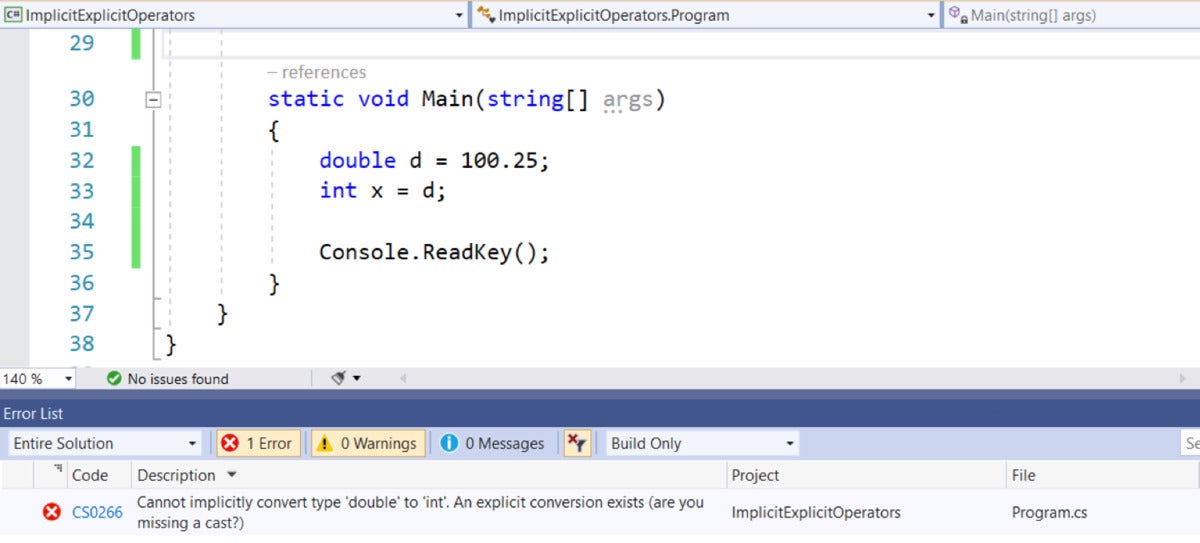

How to use implicit and explicit operators in C#
source link: https://www.infoworld.com/article/3606436/how-to-use-implicit-and-explicit-operators-in-c-sharp.html
Go to the source link to view the article. You can view the picture content, updated content and better typesetting reading experience. If the link is broken, please click the button below to view the snapshot at that time.

How to use implicit and explicit operators in C#
Take advantage of implicit and explicit operators to convert between user-defined types and improve the readability of your code.
One of the lesser known features of C# is the ability to create implicit and explicit user-defined type conversions, meaning we have support for both implicit and explicit conversions of one type to another type. We also have explicit and implicit operators, meaning some operators require an explicit cast and some operators don’t.
This article talks about these explicit and implicit conversion operators and how we can work with them in C#. To work with the code examples provided in this article, you should have Visual Studio 2022 installed in your system. If you don’t already have a copy, you can download Visual Studio 2022 here.
Create a console application project in Visual Studio
First off, let’s create a .NET Core console application project in Visual Studio. Assuming Visual Studio 2022 is installed in your system, follow the steps outlined below to create a new .NET Core console application project in Visual Studio.
- Launch the Visual Studio IDE.
- Click on “Create new project.”
- In the “Create new project” window, select “Console App (.NET Core)” from the list of templates displayed.
- Click Next.
- In the “Configure your new project” window shown next, specify the name and location for the new project.
- Click Next.
- In the “Additional information” window shown next, choose “.NET 7.0 (Standard Term Support)” as the framework version you want to use.
- Click Create.
Following these steps will create a new .NET Core console application project in Visual Studio 2022. We’ll use this project to work with type conversions in the subsequent sections of this article.
What are implicit and explicit type conversions?
An implicit type conversion is one that is done by the runtime automatically. You don’t need to cast to any specific type. Here is an example that illustrates an implicit conversion:
int x = 100;
double d = x;However, note that the following code will not compile.
double d = 100.25;
int x = d;Here’s the error you’ll observe In Visual Studio on compilation of the above code snippet.
IDG
Figure 1. The compiler won’t let you assign a double to an integer variable in C#.
The error indicates that the runtime will not convert a double to an int without explicit type casting. This type of type casting is known as explicit type casting because you must write explicit code to perform the type casting.
You can fix the non-compilable code snippet by specifying an explicit type cast of double to int as shown in the code snippet below.
int x = 100;
double d = (int) x;The above code will compile successfully without any errors.
Create model and DTO classes in C#
Let’s now understand how we can use implicit and explicit conversions in user-defined data types, i.e., classes.
Consider the following two classes.
public class Author
{
public Guid Id { get; set; }
public string FirstName { get; set; }
public string LastName { get; set; }
}
public class AuthorDto
{
public string Id { get; set; }
public string FirstName { get; set; }
public string LastName { get; set; }
}In the preceding code snippet, the Author class is the model, i.e., it represents the Author entity. The AuthorDto class represents the data transfer object of the Author class. A data transfer object is a container of data used to pass data between the layers of an application.
Convert model to DTO and vice versa in C#
The following two methods show how you can convert an Author instance to an AuthorDto instance and convert and AuthorDto instance to an Author instance.
public AuthorDto ConvertAuthorToAuthorDto(Author author)
{
AuthorDto authorDto = new AuthorDto
{
Id = author.Id.ToString(),
FirstName = author.FirstName,
LastName = author.LastName
};
return authorDto;
}
public Author ConvertAuthorDtoToAuthor(AuthorDto authorDto)
{
Author author = new Author
{
Id = Guid.Parse(authorDto.Id),
FirstName = authorDto.FirstName,
LastName = authorDto.LastName
};
return author;
}If you need to write such conversion code for several classes in your application, you will not only find it cumbersome but also your code will not have proper readability. Here is where implicit and explicit conversion operators come in.
Use the implicit conversion operator in C#
A better way to achieve the model-DTO conversions illustrated above is to use implicit and explicit operators. When you use implicit or explicit conversion operators, you don’t have to write cumbersome methods to convert an instance of one type to another. The code is much more straightforward.
The following code snippet shows how you can take advantage of the implicit operator to convert an Author instance to an AuthorDto instance.
public static implicit operator AuthorDto(Author author)
{
AuthorDto authorDto = new AuthorDto();
authorDto.Id = author.Id.ToString();
authorDto.FirstName = author.FirstName;
authorDto.LastName = author.LastName;
return authorDto;
}And here's how you can use the implicit operator to convert an Author instance to an AuthorDto instance:
static void Main(string[] args)
{
Author author = new Author();
author.Id = Guid.NewGuid();
author.FirstName = "Joydip";
author.LastName = "Kanjilal";
AuthorDto authorDto = author;
Console.ReadKey();
}Use the explicit conversion operator in C#
The following code snippet shows how you can take advantage of the explicit operator to convert an Author instance to an instance of AuthorDto class.
public static explicit operator AuthorDto(Author author)
{
AuthorDto authorDto = new AuthorDto();
authorDto.Id = author.Id.ToString();
authorDto.FirstName = author.FirstName;
authorDto.LastName = author.LastName;
return authorDto;
}In this case you’ll need an explicit cast to convert an Author instance to an AuthorDto instance as shown in the code snippet given below.
static void Main(string[] args)
{
Author author = new Author();
author.Id = Guid.NewGuid();
author.FirstName = "Joydip";
author.LastName = "Kanjilal";
AuthorDto authorDto = (AuthorDto)author;
Console.ReadKey();
}Note you cannot have both implicit and explicit operators defined in a class. If you have defined an implicit operator, you will be able to convert objects both implicitly and explicitly. However, if you have defined an explicit operator, you will be able to convert objects explicitly only. This explains why you cannot have both implicit and explicit operators in a class. Although an implicit cast is more convenient to use, an explicit cast provides better clarity and readability of your code.
Recommend
About Joyk
Aggregate valuable and interesting links.
Joyk means Joy of geeK

